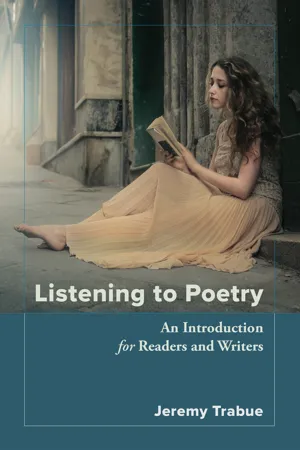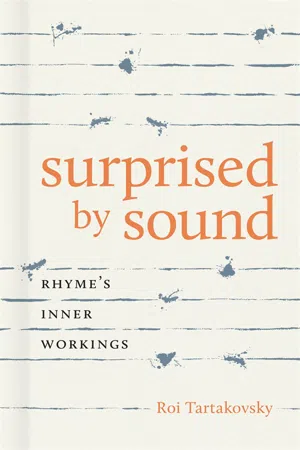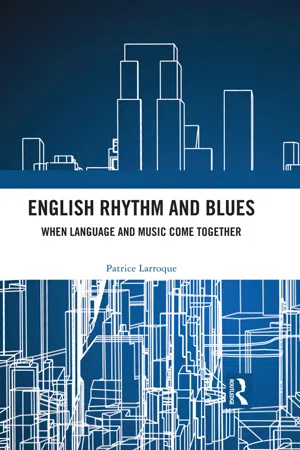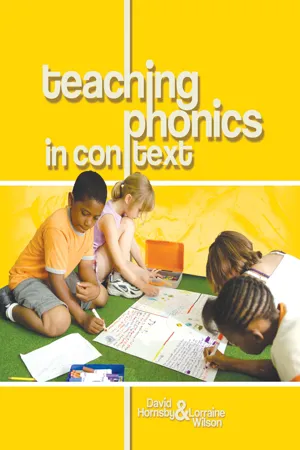Languages & Linguistics
Rhymes
Rhymes are words that have similar sounds at the end, often used in poetry and song lyrics to create rhythm and musicality. They can be categorized based on the type of sound repetition, such as perfect rhymes (e.g., cat and hat) or slant rhymes (e.g., prove and love). Rhymes are an important aspect of phonetics and phonology in language study.
Written by Perlego with AI-assistance
Related key terms
5 Key excerpts on "Rhymes"
- eBook - ePub
Listening to Poetry
An Introduction for Readers and Writers
- Jeremy Trabue(Author)
- 2019(Publication Date)
- Chemeketa Press(Publisher)
At the other extreme, there are also many people who think of nonrhyming poetry as “modern” and rhyming poetry as “traditional.” This is also inaccurate. Old English poetry did not rhyme at all, nor did much poetry in Middle English. Unrhymed verse has been part of modern English right from the beginning. Seventeenth-century poet John Milton wrote a blistering attack on rhyme in his introduction to Paradise Lost (which does not rhyme). And most early English dramatic verse is mostly written without any rhyme (though some short rhyming passages do appear in Shakespeare and other renaissance drama).The role and importance of rhyme in poetry was much debated and contested in Milton’s time, and it still is today. Unrhymed poetry is more common, but rhyming poetry is alive and well. Rhyme is not omnipotent or omnipresent. Rhyme does not define “poem.” However, it is a part of poetry, and it’s here to stay.Rhyme is one of those subjects for which the phrase “deceptively simple” was created. Most preschoolers recognize and can give examples of rhyming words. Most could easily recognize the Rhymes in this list:bed / embed / said / read bay / weigh / astray / they wing / asking / unifying / testifying lady / bee / abbey / tabbyBut what exactly makes these words “rhyming”? The entire ending syllable is not exactly the same in each one because the ending syllables may start with different consonant sounds. The spelling is certainly not the same in each one. However, the ending syllable after its initial con sonant sound is the same. Notice that they don’t have to have the same number of syllables, either, as long as that final syllable sound after its initial consonant is identical.Rhyme is the repetition of the same vowel sound followed by the same consonant sound—if there is one—in the final syllable of two or more words and in close enough proximity that it creates an obvious pattern. That’s the basic definition, but there is a lot of variation just under the surface of that definition that you should be aware of.Varieties of Rhyme
Rhyme is such a rich subject that there are different varieties of rhyme.First, Rhymes can be either internal or end. End rhyme occurs at the ends of lines, and is the most common.When people talk about rhyme, they usually mean end rhyme. Internal rhyme, - eBook - ePub
Surprised by Sound
Rhyme's Inner Workings
- Roi Tartakovsky(Author)
- 2021(Publication Date)
- LSU Press(Publisher)
1 Hearing and Listening to Rhyme If negotiating with linguistic constraints and literary conventions comes with the territory of writing poetry, rhyme occupies a great part of that territory. Certainly, in the case of English, it is difficult to overstate the association between rhyme and poetry, or the significance of rhyme to poetry. This association is attested to in rhetoric by rhyme’s synecdochic or metonymic substitution for poetry itself. Rhyme-as-poem is a prevalent trope throughout much English-language poetry and is nowhere more evident than in William Shakespeare’s ending of Sonnet 17: “You should live twice, in it and in my rhyme.” In practice, rhyme’s prevalence is attested to by the overwhelming number of rhymed poems written by generations of poets. Of course, rhyme is not the only sound device, nor the earliest in the history of English poetry. A perfect or full rhyme is, in fact, one of numerous poetic sound devices, including assonance, alliteration, consonance, and many forms of partial Rhymes. But it is the more encompassing member among most of these weaker or partial sound relations because full rhyme typically requires a correspondence of both the vowel and the following consonant sounds of the last stressed syllable of each word. 1 Assonance was never used systematically in English verse, partial rhyme is best appreciated as a subset of full rhyme, and alliteration, while carrying its own historical connotations of Anglo-Saxon prosody, seems, at least in poetic consciousness, more distant and dimmed today than rhyme. 2 Rhyme, both historically and phonetically, is set up to stand out in the soundscape of the poem or of poetry. As prevalent as rhyme is (or was —a question I will get to momentarily), it is easy to forget that rhyme’s entry into English poetry was a gradual process and one that—in spite of scholarly interest—remains somewhat murky. Murkier yet is the larger question of the historical origin of rhyme itself - eBook - ePub
English Rhythm and Blues
Where Language and Music Come Together
- Patrice Paul Larroque(Author)
- 2021(Publication Date)
- Routledge(Publisher)
The present discussion will first be an attempt to circumscribe what the notion of rhythm represents, its beats, tempo, and (especially African) influences. In this first part, the ideal eurhythmic structure of English is dealt with; it is, however, a structure which may present infractions. A second part is devoted to compensatory measures which aim at repairing these violations and thus restore the natural rhythm of English speech.2.2 RhythmThe word “rhythm” comes from Latin rhythmus, derived from Ancient Greek ρυθμός (rhuthmos, from the verb ρεϊν, “rhein,” flow) and it means two things which at first blush appear to be distinct, but are nonetheless closely related. On the one hand, it refers to a poetic form, a repetition of similar sounds in the final syllables of lines of a poem and, on the other hand, to the metric movement, to the progression, to the flow, and to the repeated occurrence of similar features or elements. These two definitions have regularity in common; the former is phonic since it organizes the sounds in the final positions of lines, and the latter is linked to harmony in that it is based on both a fluid movement (cf. the etymology of the word “rhythm”) and the regular occurrence of strong and weak beats. Thus, rhyme and rhythm contribute, at their respective level, to conveying a musical movement to the sentence.2.2.1 The notion of rhythmThe notion of rhythm supposes the repeated succession of elements, at regular intervals in time and space. We may speak of the rhythm of the seasons, the rhythm of the tides, the rhythm of the heart, or the rhythm of a piece of music. It is also called cadence when referring to poetry or a rhythmic flow of sounds in language. As Hasty (1997 : 3) summarizes, “among the attributes of rhythm we might include continuity of flow, articulation, regularity, proportion, repetition, pattern, alluring form or shape, expressive gesture, animation and motion (or at least the semblance of motion).” In his type of motion, the regularity of the succession is expected to continue (Abercrombie 1967 : 96). The result of these interactions between all these properties is that rhythm is a complex notion which combines esthetics with language dynamics and variation. Olivier Messiaen (1994–1996 - eBook - ePub
The Princeton Encyclopedia of Poetry and Poetics
Fourth Edition
- Stephen Cushman, Clare Cavanagh, Jahan Ramazani, Paul Rouzer, Stephen Cushman, Clare Cavanagh, Jahan Ramazani, Paul Rouzer, Stephen Cushman, Clare Cavanagh, Jahan Ramazani, Paul Rouzer(Authors)
- 2012(Publication Date)
- Princeton University Press(Publisher)
Rhyme is widely used not only for ludic and didactic purposes, as in rhymed and rhythmical calendrical mnemonics, children’s counting-out and jump-rope Rhymes, and jingles for ads (see Chasar) but for other types of memorable speech such as *proverbs, *epigrams, inscriptions, mottoes, *riddles, puns, and jokes (Brogan). Children seem to be able to manufacture Rhymes not only spontaneously and happily but more readily than the other six forms cited at the top of section II.B above, suggesting that the closural or “final-fixed” structure that is rhyme is somehow more salient for cognitive processing (see Rayman and Zaidel), as the vast lit. on the role of rhyme in promoting children’s phonemic awareness, lang. acquisition, and literacy suggests. Perhaps the most common form of rhyming in lang. is seen in mnemonic formulas, catch phrases that rhyme, e.g., true blue, ill will, fender bender, double trouble, high and dry. The list of such popular and proverbial phrases is astonishingly long, and the device is also used in poetry (Donne, “Song (Go and Catch a Falling Star”); Eliot, Four Quartets ; see CLOSE RHYME). In an important study, Bolinger has shown that in every lang., words that begin or end alike in sound come to be perceived as related even when they have no etymological connection. This sort of paradigmatic or synchronic associativity is even stronger than the historical kinship of words, which is often concealed by spelling and pronunciation changes, and is extended naturally into poetry as rhyme without any alteration of form or function. The inevitability of rhyme suggested by this study becomes harder to deny in light of evidence that rhyme-like structures apparently exist even in nonhuman langs., such as that of whales (Guinee and Payne), challenging those who think of rhyme as more artificial than natural to reconsider. J. S. Schütze, Versuch einer Theorie des Reims nach Inhalt und Form (1802)—Kantian semantic theory; T - eBook - ePub
- David Hornsby, Lorraine Wilson(Authors)
- 2010(Publication Date)
8Phonics in Context: RhymesI n Chapter 1 we began by saying that explicit teaching of phonics occurs within the context of authentic reading and writing events. Because particular sounds are repeated throughout a rhyme, a rhyme provides an authentic, usually short, written text that is rich in possibilities for children investigating the sounds of the language. Whereas English phonemes differ from the phonemes heard in the first languages of English language learners, Rhymes provide an excellent oral text for immersing these learners in the sounds of English. Hence Rhymes are particularly important in the language programs of English language learners.Additionally, Rhymes are contextually rich for learning sound–letter relationships—that is, phonics. Rhymes can be used to learn about phonics at all levels throughout elementary school. When children study the sound–letter relationships in rhyming words they find in familiar rhyming texts, they form generalizations that can then be applied as they read and write other texts.Rhymes come in a wide variety of different types. Many parents perform Rhymes with their babies, such as “This Little Piggy Went to Market,” which involve rhyme and actions. Action Rhymes, such as “The Grand Old Duke of York” or “Skipping Is Fun,” are also very appropriate in kindergarten classes. Many teachers of kindergarten and first and second grades have a collection of finger Rhymes, such as “Here Is the Church,” that they use as a way of getting all children’s attention. Other Rhymes lend themselves to oral performances in which individual children read the different lines in turn.Children from every culture have a rich heritage of songs, Rhymes, and games, and they enjoy them just for the pure pleasure of saying the poem or singing the song. Fortunately, sharing these Rhymes helps them develop phonemic awareness without artificially pulling the Rhymes apart. (Taylor, 1998, p. 16)
Index pages curate the most relevant extracts from our library of academic textbooks. They’ve been created using an in-house natural language model (NLM), each adding context and meaning to key research topics.




